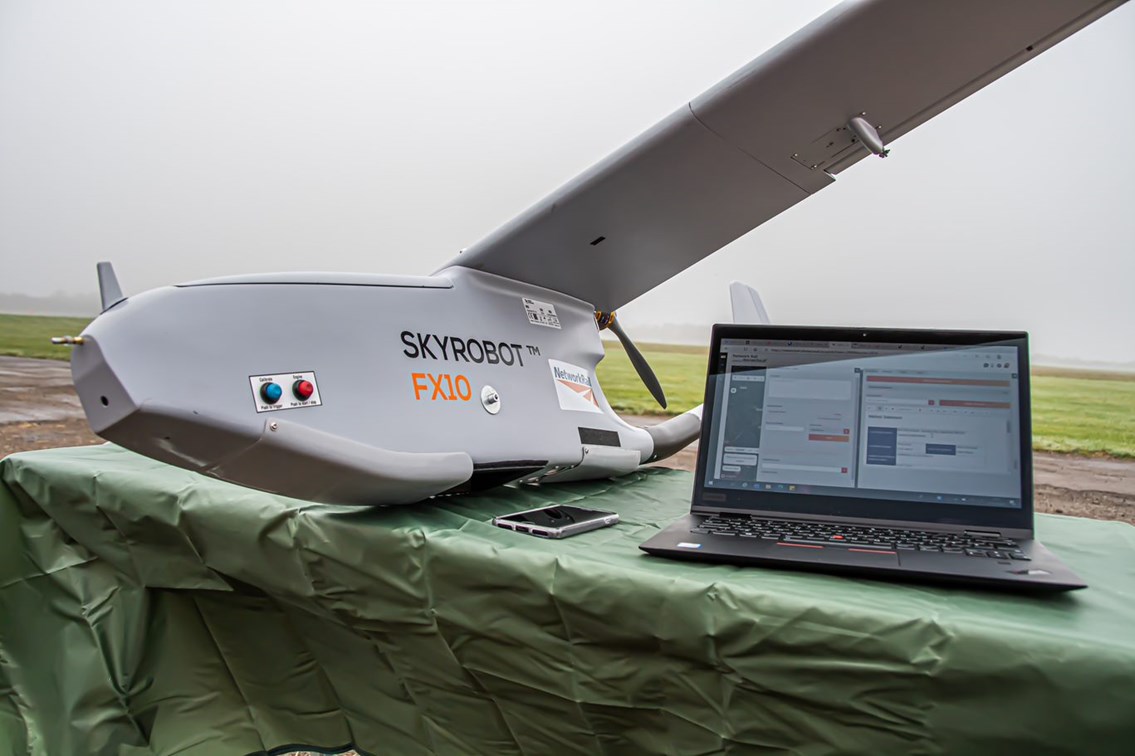Thursday 28 Oct 2021
Network Rail completes longest civilian BVLOS drone flight over dry land
- Region & Route:
- National
Network Rail’s air operations team have successfully flown a drone Beyond Visual Line of Sight (BVLOS) for 25 kilometres over dry land – believed to be the furthest such civilian drone flight in Britain.
The proof-of-concept flight – which took place yesterday (Wednesday 27 October) from Bicester along the East West Railway – is the culmination of 18 months of work. It is a significant step forward in terms of how drones can be used to inspect the railway safely, quickly and cost-effectively.
Drones and helicopters have long been used by Network Rail to identify faults on the railway, helping to predict and prevent failures to reduce disruption for passengers, while also representing a safer form of maintenance by limiting the number of manual inspections that need to be carried out by foot.
Until now, drones were only ever flown above the railway when they were in clear sight of the operator, and usually only for four or five kilometres at a time. While this can still be a helpful tool to inspect Britain’s rail infrastructure, it requires the team involved to set up multiple times at different locations. The ability to fly Beyond Visual Line of Sight enables the air operations team to inspect the railway over a much larger area while saving valuable time and costs.
Rikke Carmichael, Network Rail’s head of air operations, said: “While flying Beyond Visual Line of Sight will ultimately provide us with much greater capability, it is worth emphasising that this was a proof-of-concept flight, and that a shift to using BVLOS as business as usual will take some time.
“Nonetheless, yesterday was an important milestone and I’d like to thank my team for all their hard work on this project over the last couple of years. We’ll now turn our attention to agreeing a strategy for using drones both VLOS and BVLOS, after which we will want to engage with industry for the next exciting phase of BVLOS becoming another routine service the Air Ops team provides the business.”
A Network Rail helicopter also flew alongside the drone to test whether or not the two could work together, and whether their respective systems recognised each other. It was proved that they did work effectively together. Data captured by the helicopter will be used to create a ‘digital twin’ of the railway that was flown over.
Notes to editors
- The drone was flown on 27 October from the Bicester Aerodrome, part of the Bicester Motion site, along the East West Railway.
- This was a proof-of-concept flight which proved the capability for drones to be flown on the railway beyond visual line of sight (BVLOS).
Contact information
Passengers / community members
Network Rail national helpline
03457 11 41 41
Latest travel advice
Please visit National Rail Enquiries
Journalists
Jack Harvey
Jack.Harvey2@networkrail.co.uk
About Network Rail
We own, operate and develop Britain's railway infrastructure; that's 20,000 miles of track, 30,000 bridges, tunnels and viaducts and the thousands of signals, level crossings and stations. We run 20 of the UK's largest stations while all the others, over 2,500, are run by the country's train operating companies.
Usually, there are almost five million journeys made in the UK and over 600 freight trains run on the network. People depend on Britain's railway for their daily commute, to visit friends and loved ones and to get them home safe every day. Our role is to deliver a safe and reliable railway, so we carefully manage and deliver thousands of projects every year that form part of the multi-billion pound Railway Upgrade Plan, to grow and expand the nation's railway network to respond to the tremendous growth and demand the railway has experienced - a doubling of passenger journeys over the past 20 years.
Follow us on Twitter: @networkrail
Visit our online newsroom: www.networkrailmediacentre.co.uk

